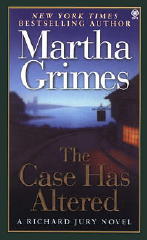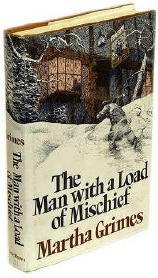Fri 7 Mar 2008
MARTHA GRIMES – The Case Has Altered.
Onyx; paperback reprint, November 1998. Hardcover first edition: Henry Holt & Co., October 1997.

Yes, in case you were wondering, and I realize that you probably weren’t, there are authors whose mystery fiction just doesn’t — how shall I say this? — work for me. Take Martha Grimes, for example. For all of her popularity — she has to be, since this is the 14th of 20 cases of Scotland Yard Superintendent Richard Jury that she’s written about, along with four adventures of 12-year-old Emma Graham (about whom I otherwise know nothing at all) and a small assortment of stand-alone’s — I’ve never been able to finish one before, and believe me, I’ve tried. In fact, if you really must know, I nearly quit on this one after exactly 73 pages in.
I know the number of pages because that’s when I stopped and wrote a first version of this review — and by the time the next morning had rolled around, I’d thought better of it. At least I got it out of my system.
I almost never quit on a book. I figure that when the going gets tough, it’s just me, and in all fairness, I can’t write a review of a book I hadn’t finished, now could I? So with The Case Has Altered (the name of an English pub, as usual) firmly back in hand, I continued on to the end, and all in all, I’m glad I did.
But here’s the crux of the problem. There is a knack that the writer of a series of detective stories, all with the same leading characters, has to have, or so it seems to me. And that’s to introduce these people clearly and eloquently to the reader who’s starting with the book he or she has in her hand so that at least they have an idea of which way is up and where that part of the story is going.
This is especially true, as it is in The Case Has Altered, when a good part of the story has to do with the relationships between two and maybe three of the characters, and it’s crucial to know exactly what they are. At the same time, of course, you’ve got to do it without boring to tears the ones who’ve been along for the ride since book one. (A cover image of that very same book one is shown below, left.)
Ms. Grimes, deliberately, one supposes — how else can one explain it? — goes for the non-boring approach, and the first-time reader is caught flat-footed and totally lost, caught up as it were in the middle of the second act when they’ve only just opened the book. Superintendent Jury seems to be in love with Lady Jennifer Kennington, and so’s his good friend Melrose Plant. Is there a competition there? Or was there? It is not clear, though it does become clearer — and even so, is this a relatively new love, or a long-abiding one?
And when Jennifer appears to be the number one suspect in a double killing in the Fens of Lincolnshire county, it is not all clear why Jury does not simply stop by and ask her. What’s up with this double killing, he might ask her, but perhaps less directly. No, he does not. There are telephones in this otherwise nearly timeless world in which Jury and his friends live, but are they used in the way that they’re intended to be used? No.

But perhaps he does not want to know the answer, or perhaps she is not so much in love with him as he is with her, or maybe neither loves each other very much at all, only an attraction perhaps? We the reader have no clue, at least the first time reader, for apparently the relationship has come up before, or maybe it hasn’t, because I don’t know, not having read any of the earlier ones.
Nor was I wrong in thinking that a couple of chapters are missing, because a reviewer on the Amazon website said the very same thing: when did Melrose Plant’s search for Jenny take place, since it came up later and had never been mentioned before?
There are, I hasten to add, some absolutely wonderful characters in this book. Absolutely wonderful, and the scenery of the Fens is described so beautifully (for what is essentially swamp land, that is) as to take you right there. Not that it’s likely I’ll ever go, and for now, I don’t need to. I’ve already been given a guided tour, and every part of the story that takes place there is exquisitely fascinating.
Melrose Plant also does a smashing (and utterly amusing) job impersonating an antiques appraiser while snooping around on Jury’s behalf. It is not entirely clear how Jury has so much free time to do the investigating he does on his own, and he does, but talk to Jenny? No. Not until page 192, after she’s been arrested, do we have any idea of what her side of the story might be, nor is she telling him everything then.
And my goodness. 427 pages. No wonder some of the twists and turns the plot takes don’t make any sense, or how some of the more minor characters are so poorly remembered (or not at all) when they are called upon to take their turn on the stage again.
One more thing, if I may. If I could advise Ms. Grimes about her characters, I’d tell her leave Melrose’s outrageous Aunt Agatha, her lawsuits and her other antics out completely, or at the very least, trim her role way back. This portion of the tale, included for comedy relief perhaps, goes absolutely nowhere, and do I mean nowhere? Yes.
Will I attempt another mystery written by Martha Grimes? Previous comments aside, I might surprise you and say yes, now that I know the characters, but in all likelihood, the honest answer is probably not, not right away. There are too many other books to read before undertaking another one that’ll require a whole week of evenings at bedtime to read, only to leave you with as many mixed feelings as this one does — the primary one being that of frustration.
Nor am I the only one. Read the other reviews on Amazon. They’re all over the board, just as my reactions are. I have no doubt that they’re honest, from out-and-out praise to “dump this one in the garbage pail.” Me, I’m somewhere in between, as I’m sure you can tell.
March 7th, 2008 at 4:56 pm
Heaps of good sense here about books in series. It applies whatever the genre. Unless you are one of a handful of “name” authors, the haphazard nature of how your books are stocked by retailers or libraries means you have no guarantee that readers will have access to even the last book published. Each time, you have to assume none of your readers knows your characters, the nuances of their relationships and what has gone before. In the bygone times many of us here miss, serials in magazines used to have small-print paragraphs at the top of the current instalment finishing “Now read on”, or somesuch. Today, we don’t have the advantage of that ploy and must work the background material into the text at hand. And do it without irritating the reader who has seen it all before. It becomes quite a demanding art!
March 8th, 2008 at 12:11 am
Chap,
Thanks for the input from a writer’s point of view. You’ll hear no disagreement from me. You said it well.
What puzzles me is that Martha Grimes must know what she’s doing, and she must have thought it a good idea in mind to keep Jury away from Jenny for so long. But in terms of story structure, it doesn’t work. Not only does it keep the new reader uninformed as to the exact relationship between them, it’s simply awkward in the telling. Yes, Jenny has some secrets (I’m not giving anything away), but the two of them could have met much earlier than they did, and the background between them brought out much sooner.
And keeping them apart produces an even bigger problem. It makes it seem that the author is too anxious to keep the mystery from being solved earlier than it is. As a technique in a mystery writer’s big of tricks, it’s an awfully weak one.
— Steve
August 29th, 2010 at 3:44 pm
[…] for the fans of Grimes’ Jury series except for a couple of drawbacks. Steve Lewis said in his review of The Case Is Altered that if you don’t start by reading Grimes’ Jury series from the […]
February 1st, 2011 at 3:46 pm
[…] Black Cat (by Ray O’Leary) The Case Has Altered (by Steve Lewis) […]